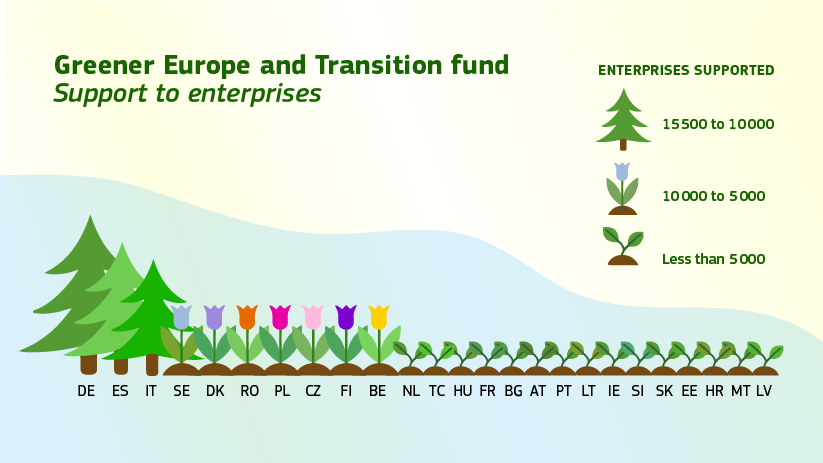
The potential impact of the green transition on employment is a big concern among Europeans. Many people fear widespread job losses. To prevent such a scenario, it is vital to create green jobs.
A green job can be defined as employment in a sector which is both more competitive and more sustainable than the EU average. In this sense, competitiveness is measured in terms of average wage, expressed in purchasing power standard to allow comparison between regions; sustainability is measured by greenhouse gas emissions per employee.
Moreover, green jobs contribute to preserving or restoring the environment. As well as limiting emissions, they improve energy and raw material efficiency, minimise waste and pollution and support adaptation to climate change. They also provide goods or services that benefit the environment or contribute to more environmentally friendly production processes.
In 2019, 17 % of jobs in the EU were defined as ‘green’, although the share fell in subsequent years due to job losses caused by the COVID-19 pandemic. Moreover, the picture as regards green job creation is mixed, with significant regional disparities across the EU.
Regional divides
Figures from 2019 show that shares of green jobs in the EU were highest in southern Germany, northern Austria, southern Ireland, southern Scandinavia and capital regions, and much lower in most parts of eastern Europe.
More developed regions – those with per capita gross domestic product (GDP) above the EU average – have significantly higher shares of green jobs than both transition regions – those with per capita GDP of 75 %-100 % of the EU average – and less developed regions – those with per capita GDP below 75 % of the EU average.
Furthermore, the gap between the more developed regions and the rest is growing. In 2008, shares of green jobs in more developed, transition and less developed regions stood at 19.6 %, 9.8 % and 6.8 % respectively. However, while the figure in more developed regions reached 26.3 % in 2019, that in transition regions increased more slowly over the same period, to 13.8 %. The situation in less developed regions was largely stagnant from 2008 to 2020, when the share of green jobs was just 6.7 %.
Although shares of green jobs in all three categories of region fell as a result of the pandemic, developed regions remain much better prepared for the green transition. Other regions are struggling due to various factors: difficulty attracting investment, outdated infrastructure, a lack of entrepreneurship and innovation, and insufficient numbers of people with the right skills.
As well as making it more difficult for transition and particularly less developed regions to become greener, these issues hamper their competitiveness. Such regions are thus at risk of entering a vicious cycle where their attractiveness to business is further diminished, leading to job losses, industrial decline and workers moving away.

Why cohesion policy matters
The widening geographical disparities in shares of green jobs point to an important role for cohesion policy in enhancing the sustainability of regional economies.
Investments through the European Regional Development Fund (ERDF), the Cohesion Fund (CF) and the European Social Fund have a proven track record of boosting regional competitiveness. They have enabled regions to restructure and switch to higher value-added sectors. This is particularly evident in less developed regions, which receive the largest amounts of funding.
Regarding sustainability, however, evidence for improvements arising from cohesion policy investments is thinner on the ground. Greater sustainability thus appears more difficult to achieve, indicating that the transition to a green economy will require more time and effort.
Factors such as research and innovation, good governance and a skilled workforce are important in this regard. In addition, appropriate policy decisions, reforms and investments are essential for balancing the green transition with the promotion of employment, competitiveness and growth.
Cohesion policy support
For the 2021-2027 period, cohesion policy funding is delivering more than EUR 118 billion worth of investment in climate action – a huge increase from the EUR 52.5 billion invested during 2014-2020. This represents a significant contribution to the efforts to achieve the EU’s climate goals of reducing net greenhouse gas emissions by at least 55 % by 2030 compared to 1990 levels and making Europe climate neutral by 2050.
Given the scope of their objectives and the scale of their budgets, the ERDF and the CF account for a large part of this contribution. The EU has committed to investing 33 % of ERDF and 56 % of CF resources in climate action during 2021-2027 – around EUR 70 billion and EUR 22 billion respectively. As well as reducing emissions and reinforcing adaptation to climate change, the investments will create jobs; foster economic activity; support businesses, particularly in innovation and competitiveness; and promote balanced territorial development.
Alongside the ERDF and the CF, the European Social Fund Plus, the EU’s main instrument for investing in people, will facilitate Europeans’ acquisition of green skills and creation of green jobs with around EUR 6 billion in funding.
A new cohesion policy instrument for 2021-27 is the Just Transition Fund (JTF), which supports the regions most affected by the negative impacts of the green transition. Over EUR 19 billion is to be made available for that purpose and will help around 40 000 companies to adapt. When JTF support is added to that provided under the greener Europe objective of the 2021-2027 cohesion policy, nearly 100 000 enterprises are set to receive assistance in making the transition.
Finally, 724 000 businesses will obtain funding to innovate and boost their competitiveness under the Smarter Europe cohesion policy objective, in line with smart specialisation strategies, many of which are focused on low-carbon economy themes.
Find out more
https://cohesiondata.ec.europa.eu/stories/s/py4s-5ad4
https://ec.europa.eu/regional_policy/funding/just-transition-fund_en